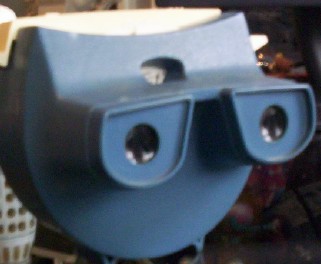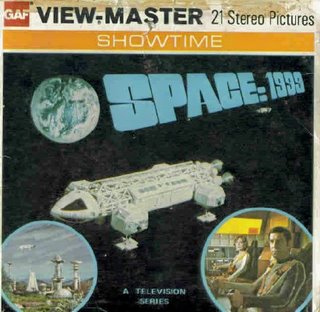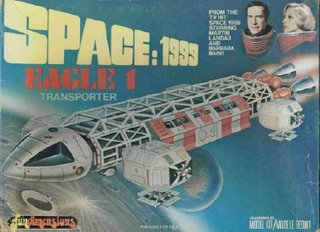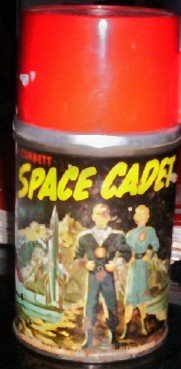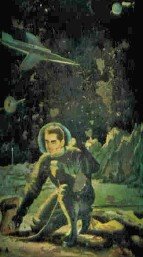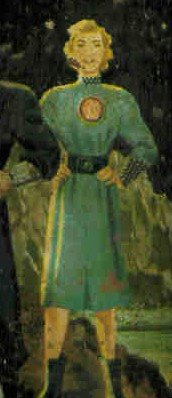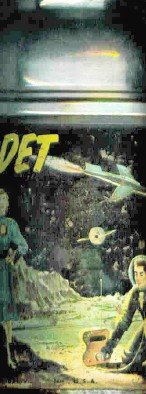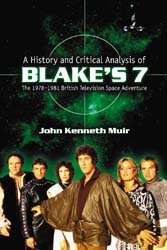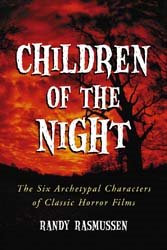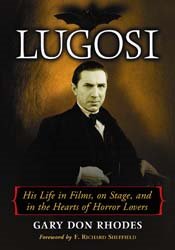In addition to being a rip-roaring horror film filled with suspense and terror, director Wes Craven's Scream (from a screenplay by Kevin Williamson) serves as the ultimate tale of America's VCR generation. The imperiled (and sometimes murderous) teenagers portrayed in the film, with their Pentium computers, pagers, cell phones, and extreme cynicism are an ideal reflection of the mid-to-late 1990s. Like many young adults of that day, these fictional (and very smart) teens are acutely conscious that their new technological toys are not really helping anyone, making things better, or saving the world. Despite e-mail, MRIs, and the Hubble, the world is still fraught with dangers. AIDS is still out of control (a dozen years after its discovery...), the national deficit is tremendous and growing by the minute, and Generation X'ers and Y'ers are not leaving universities for $50,000-a-year careers. Companies are downsizing, and Congress is locked in partisan games.
So, on the contrary, the teens of the 1990s have discovered - first-hand - by the time of Scream that the artificial prosperity of the Reagan era - the era of their youth - is over indeed, and that they will be paying for the 1980s for the remainder of their adult lives. The result of this insight is that the high-schoolers profiled in Scream often seem cynical or callous.
For instance, consider Tatum's (Rose McGowan's) retort to Sidney (Neve Campbell) after Sidney notes that murdered classmate Casey Becker (Drew Barrymore) sits next to her in English class. "Not anymore," Tatum comments straight-faced, more interested in a pithy one-liner than a fallen comrade, another human being.
Later, two students at Sidney's school thoughtlessly dress up as the psycho killer terrorizing the town, not even considering the results of their actions. All they seem to care about is their own entertainment, not the feelings of others. When principal Himbry (Henry Winkler) is murdered, it is an amusing incident to these same teenagers. They do not think of the administrator as a human being, only a nemesis who keeps them from having their way at school. His children, his wife, his friends, don't matter to them. All they want is a good time. As Alice Cooper's song tells us on the soundtrack, "School's Out."
The moment of greatest cynicism in Scream occurs during a short scene in the girl's high school rest room. A cheerleader suggests to her friend that Sidney herself is the notorious Woodsboro murderer. She knowledgeably rattles off a complicated psychological argument for this revelation, and then reveals that her source for it is The Ricki Lake Show. Does anyone recall how, a decade ago, slimy talk shows like this (and The Jerry Springer Show) were all the rage? Some examples of the format may still be around today, but they're not the cultural cause celebres they were in the 1990s.
In scenes like these, Craven (and indeed, Scream) suggests that because of intense exposure to TV, movies, and other mass media, some 1990s teens are not only callous and cynical, but unbelievably knowledgeable. It is a defense mechanism, perhaps. They have to be smart to understand the Internet and other tools of modern life. But by the same token, exposure to sanitized movie violence has left some teens with no concept of real human pain or empathy. Perhaps the best moment in the film occurs when villains Stu (Matthew Lillard) and Billy (Skeet Ulrich) stab each other to make it appear that they were victims of the maniac. They seem shocked when they realize that it actually hurts to be stabbed! For the first time (and only briefly), Stu and Billy are able to sympathize with their victims. Movies and TV have not prepared them for the fact that it hurts to bleed, to be stabbed. After all, they grew up with the A-Team, wherein cars would flip, machine guns would blare and nobody would get hurt.
Scream is perfect not only in its dramatization of mid-1990s high school set, but also in its self-aware, hip attitude attitude. The film is undeniably clever, much like the cadre of kids it highlights. The teens endlessly wonder about who will play them in the inevitable movie version of the killing spree ("With my luck, they'll cast Tori Spelling...") or comment that their lives are just like movies ("This is like Silence of the Lambs when Jodie Foster kept having dreams of her dead father...") To think, citizens once referenced literature, national leaders, philosophers and the like! All this generation can muster in this time period, it seems, comes from pop culture cornerstones. That may be because the leaders of the day (like Bob Dole, Newt Gingrich, and Bill Clinton) really didn't have much memorable or significant to offer, did they? They didn't call for energy independence from the Middle East, a new environmentalism, or anything truly important. Today, we can see how changes ten years ago would have drastically improved our state today.
Interestingly, all of the pop culture references serve a purpose within the text of the film: they form a portrait of children who have not been raised by their parents (who seem perpetually absent; gone away on "business"). Instead, they were raised by the local video store, cable TV, and the ubiquitous VCR. Craven's subtext in Scream might just be that parental absenteeism has left a generation of disaffected children at the mercy of pop culture and television. As a result, this generation thinks in terms of sitcom one-liners, movie references, and TV-style ethics rather than what one might consider traditional American values vetted by public institutions of education, family and faith.
Craven expresses the prominence of the television in contemporary teenage life by cleverly positioning TV sets in many of his compositions throughout Scream. When Casey Becker is tormented by the killer, she seeks refuge between a wall and a TV. Questioned about Halloween and Friday the 13th, she is literally trapped between the TV and a hard place.
When Randy (Jamie Kennedy) enlightens his friends about the "rules" of horror movies, he too is positioned next to a giant-screen TV, which features a freeze frame image from Halloween. As Randy lectures, the knife of "The Shape," Michael Myers, (on the TV) points dangerously in his direction, not so subtly suggesting that he too will be a victim of the TV-conscious killer.
And, of course, in the ultimate use of a TV set, Sidney drops one onto Stu's head during their life-and-death confrontation. Parents like to warn that getting too close to the TV could hurt you, and in Stu's case that is absolutely true! (And, in a nod to another genre film, this death reflects a murder in the 1980 slasher film, Mother's Day).
In addition, all the action of the final party sequence of Scream is also shown on news woman Gale Weathers' video monitors. So while the partygoers watch TV, there is a camera watching them watching TV. A step further beyond that, the audience is also watching characters watching other characters, and so on. Thus Craven's world is one of an endless circle of television watching and media stardom.
It is interesting for example, that every character in Scream is in some manner connected to television. Gale Weathers (Courteney Cox) is a celebrity, a TV news reporter. Sidney is forced to watch incidents from her life unfold on TV (particularly the investigation surrounding the death of her mother). Tatum and Sidney both make the Nightly News after surviving an attack, and so on. Thus Craven documents something new and interesting in American culture in this film: the TV generation has come of age only to discover (especially in Stu, Billy and Kenny's case) that TV is really harmful to one's health.
Scream is a great horror film of the 1990s not simply because it reflects it context and the young generation of its time, but because it boasts a genuinely brilliant structure. The film's makers apparently share the audience's boredom with formulaic horror pictures and sequels. Thus Scream trots out all the same tropes that kids have seen in everything from Child's Play to A Nightmare on Elm Street to Hellraiser and other popular franchises of the 1980s. Then, it spins these film conventions in daring and bold ways.
In Scream, Randy is a movie buff, and he dutifully recounts all the rules of horror movies (including no drugs, no sex, and no promise that you'll be 'right back.') Scream declares these paradigms "operative", then, in short order, subverts them. Sidney gives up her virginity (a death sentence in the genre...) but lives to fight another day. The killer appears supernatural (like Michael, Jason or Freddy) but is no boogeyman, just two movie-whacked kids. Likewise, Sidney rails against stupid girls in horror movies who run up stairs instead of evacuating the house, but at the first sign of danger, runs up the stairs. These twists on convention make Scream an endlessly entertaining film, and perhaps (along with 1999's The Blair Witch Project) the horror film which most beautifully represents the era of its creation.
It is funny, however, how Scream seems much more campy today than it did a decade ago. Ten years ago, the film was genuinely scary. Today it feels predominantly caustic, slick. But that might just be what the definition of "is" is in 1990s horror.






